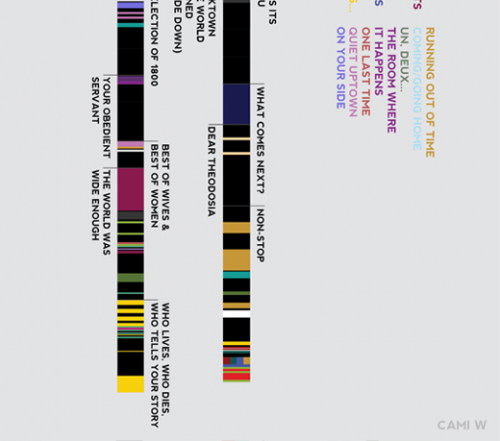In an upcoming lesson plan, I introduce some ways in which visualization be used to analyze elements of a literary text such as genre, theme, motifs, or plot structure. However, that lesson plan focuses predominantly on visual works. What are some of the ways in which visualization could be used to explore sound compositions, such as music?
Visualizing audio texts allows students in literature classes to convey information without requiring a background in musical theory. For students (and instructors) who want to write on an audio texts, but lack technical vocabulary, visualizing the structure of a musical piece or era provides evidence necessary for their argument without requiring them to verbally “summarize” a musical genre or piece of music.
The linear evolution of musical influence and genre can be traced in the same way as the linear evolutions of literary genres (with the same limitations and caveats of the chronological analytic approach). The interactive project Musicmap visually maps different genres together based on similarity.

This infographic appears to be organized spatially rather than chronologically. However, clicking on any particular column will provide a brief chronological and cultural description of the genre or movement.

Musical genres can also be mapped by network relations. One example is the interactive graphic Every Noise At Once, which creator Glenn McDonald describe as “ongoing attempt at an algorithmically-generated, readability-adjusted scatter-plot of the musical genre-space, based on data tracked and analyzed for 1491 genres by Spotify,”[x], categorizes musical genres by influence but not linear chronology. Clicking on a genre title provides a short audio sample. Every Noise at Once also organizes the genre in list form to enable the user to look up a specific genre without reading through the entire map.

The benefits of this method is ease of reading genre similarities without the limitations of tracing “influence.” The limitation of this method is that network visualization can risk de-historicizing the music.
Visualization can be also be used to close read individual texts. Narrative works such as Broadway musicals or opera can also be analyzed on the level of sound. For example, this infographic visualizes the structure of the Broadway musical Hamilton. While the play could be — and has been — analyzed on the level of rhyming schemes or lyrical intertextual references, this infographic color-codes specific key melodies to read the musical intertextual references.

What information does this graphic convey about the play’s structure? For one example, the increasing amount of colors at the end of each line show that both acts of the play end with reprising multiple melodies. For another example, notice that there are colors at the end of the second line — such as yellow — that have not appeared since the first line. This signifies that the show ends by reprising melodies that have not been heard since Act I.

The important point is that the infographic presents textual evidence from a work — in this case, a musical — to an audience without assuming that the audience is intimately familiar with the text. This rhetorical strategy saves time in a conference presentation or class lecture in which the speaker may not have time, or technology, to provide audio samples for the audience.
While the actual creation of complex visualizations may be beyond the scope of the beginning user, students and scholars would be behooved to understand how visualizing sound texts works as a rhetorical strategy for conveying information, particularly in cross-disciplinary literary analysis.


